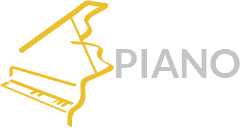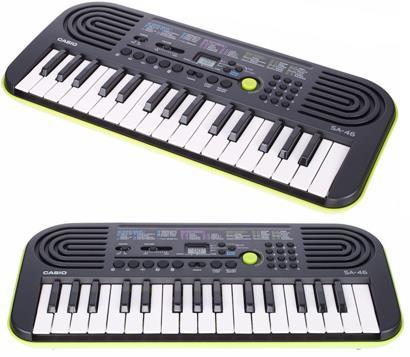
Casio Digital Piano SA 46 Review Complete Is it a good choice?
Casio has always had a catalogue of miniature keyboards, which can serve as a gift for a child with a musical aptitude or for a person who has the desire to start learning to play the keyboard on a very limited budget, as they are worth around €38/$44/£35.
The Casio SA- 46 can be a fun keyboard that can be useful in certain cases and here we show you its main features:
- 32 mini keys without sensitivity levels
- 8 notes of polyphony (Number of notes that can be played at once. This includes the accompaniments that also consume notes. So if you play over an accompaniment more notes will be accumulated)
- 100 sounds (Different sounds of piano and other instruments)
- 50 styles (Accompanying styles that adapt to the chords we are playing. For example they will put a bass and a drum kit that will adapt and synchronize with the notes we are playing on the keyboard)
- 10 themes to practice
- 5 pads to create rhythms (accompaniment rhythms that adapt to what you are playing. There are bossa nova rhythms, etc. Sometimes they are also known as accompaniment styles)
- lC display
- Two very low power 0.5 W speakers, it’s almost a toy
- Headphone output
- It only weighs 1 KG
- Powered by batteries or a transformer not included, the Casio AD-E95100 adapter is ideal for children
You have to have that for a beginner this keyboard is very short. With such a small polyphony you can’t play with accompaniments and you lack sensitivity in the keys. So the note you play at the same volume always sounds. On the other hand, it doesn’t have MIDI or input for a sustain pedal either. Which are necessary elements to learn piano at a minimum level. I invite you to see the piano selections you will see in this blog to look at other keyboards that do have those extras and cost a little more than 100 euros.
I have selected a couple of videos for you to listen to their sounds and the possibilities they offer. Keep in mind that what you pay for, of course… Then the comparisons below
Related post you can be interested in
- Ranking with the best digital pianos
- My selection of cheap musical keyboards.
- Basic concepts you need to know about digital pianos.
- The best resources to learn to play the piano by yourself.
- The best Casio Digital Pianos.
Now let’s compare the Casio SA 46 with its more common alternatives. Also at the end of the post you will find a section with the best purchasing options for this keyboard. But you can go directly to that part of the post by pressing the next button.
Casio SA 46 vs Casio SA 47
Actually both Casios 46 and 47, are almost identical. Since both have the same value €38/$44/£35, and have very similar characteristics that you will surely find later. One notable difference is that the base of the SA 46 is green, and the Casio SA 47 is black like the rest of the body.
We will put the characteristics of each of these pianos in 2 different columns to make it easier to see the differences:
|
Casio SA 46 |
Casio SA 47 |
|---|---|
|
|
A video where you see the physical differences between them:
If you want to know more about this model do not miss our review of the Casio SA 47.
Casio SA 46 vs Casio SA 76
Now we will have the comparison between these two Casios the SA 46 that as we have commented its value is of €38/$44/£35 and the SA 76 that its value is of €57/$54/£52, let us verify if the difference justifies thanks to the characteristics that it offers us.
- The SA 46 has 32 mini keys (for children/persons with small hands) and the SA 76 has 44 mini keys, none of which are sensitive to touch. This means that even if you press hard or softly the keys will sound the same.
- Both have: 8 notes of polyphony, which means that up to 8 notes can be played at the same time. Both have 100 different sounds, 50 styles/rhythms to accompany, 10 songs to practice and 5 Drum-pads to play rhythms or percussions.
- The SA 46 has 0.5W speakers, which are not very powerful. The SA 76 has 0.8W speakers which are a bit more powerful than the SA46.
- The weight of the SA 46 is only 1 kg and the SA 76 is 1.4 kg.
- A notable difference is that the base of the SA 46 is green and the SA 76 is orange.
We will put the characteristics of each of these pianos in 2 different columns to make it easier to see the differences:
|
Casio SA 46 |
Casio SA 76 |
|---|---|
|
|
Here’s a video of the Casio SA 76:
If you want to know more about this model don’t miss our review of the Casio SA 76
Casio SA 46 vs Casio SA 77
Now we will have the comparison between these two Casios the SA 46 that as we have commented its value is of €38/$44/£35, and the SA 77 that its value is of €57/$54/£52, let us verify if the difference justifies thanks to the characteristics that it offers us.
- The SA 46 has 32 mini keys (for children/persons with small hands) and the SA 77 has 44 mini keys, none of which are sensitive to touch. This means that even if you press hard or softly the keys will sound the same.
- Both have: 8 notes of polyphony, which means that up to 8 notes can be played at the same time. Both have 100 different sounds, 50 styles/rhythms to accompany, 10 themes to practice and 5 Drum-pads to play rhythms or percussions.
- The SA 46 has 0.5W speakers, which are not very powerful. The SA 77 has 0.8W speakers which are a little more powerful than the SA 46.
- The weight of the SA 46 is only 1 kg and the SA 77 is 1.4 kg.
- A notable difference is that the base of the SA 46 is green and the SA 77 is black.
We will put the characteristics of each of these pianos in 2 different columns to make it easier to see the differences:
|
Casio SA 46 |
Casio SA 77 |
|---|---|
|
|
Now a video of the Casio SA 77
If you want to know more about this model don’t miss our review of the Casio SA 77
Casio SA 46 vs Casio SA 78
Now we will have the comparison between these two Casios the SA 46 that as we have commented its value is of €38/$44/£35,38 euros and the SA 78 that its value is of €57/$54/£52, let us verify if the difference justifies thanks to the characteristics that it offers us.
- The SA 46 has 32 mini keys (for children/persons with small hands) and the SA 78 has 44 mini keys, none of which are sensitive to touch. This means that even if you press hard or softly the keys will sound the same.
- Both have: 8 notes of polyphony, which means that up to 8 notes can be played at the same time. Both have 100 different sounds, 50 styles/rhythms to accompany, 10 themes to practice and 5 Drum-pads to play rhythms or percussions.
- The SA 46 has 0.5W speakers, which are not very powerful. The SA 78 has 0.8W speakers which are a little more powerful than those of the SA 46.
- The weight of the HS 46 is only 1 kg and the HS 78 is 1.4 kg.
- A notable difference is that the base of the SA 46 is green and that of the SA 78 is red.
We will put the characteristics of each of these pianos in 2 different columns to make it easier to see the differences:
|
Casio SA 46 |
Casio SA 78 |
|---|---|
|
|
Here is a video showing an unboxing and small review of the Casio SA 78:
If you want to know more about this model don’t miss our review of the Casio SA 78
Where to buy Casio SA 46
Amazon
- Free Shipping and possibility of shipping in one day with Amazon Premium.
- Full Guarantee but they are no experts in music equipment.
- Sometimes better price.
- He’s got worse stock than Thomann.
Thomann
- Free Shipping.
- Full warranty. If you have any problems, they take care of everything.
- 100% reliable payment.
- Leader in trouble-free shipping.
- Usually Best price.
- Best Reputation: They are the leading online store in Europe and have the best catalogue and information.
Check below related models with similar price and features:
- Thomann DP 26
- Thomann SP 320
- Yamaha NP 32 Piaggero
- Korg Tiny Piano
- Startone MK 300
- Startone MK 200
- Yamaha PSR E463
- Yamaha PSR E363
- Startone MKR 61
- Roland GO KEYS
- Casio SA 46
- Casio SA 47
- Casio CTK 240
- Casio CT X700
- Yamaha EZ 220
- Yamaha PSR E263
- Yamaha PSR EW300
- Casio LK 280
- Casio SA 76
- Casio CTK 3500
- Casio LK 265
- Casio LK 136
- Casio CTK 1500
- Casio SA 77
- Yamaha Sonogenic SHS 500
- Casio SA 78
- Casio CTK 2500
- Yamaha YPT 260
- Roland GO PIANO
- Midiplus Stage 88


